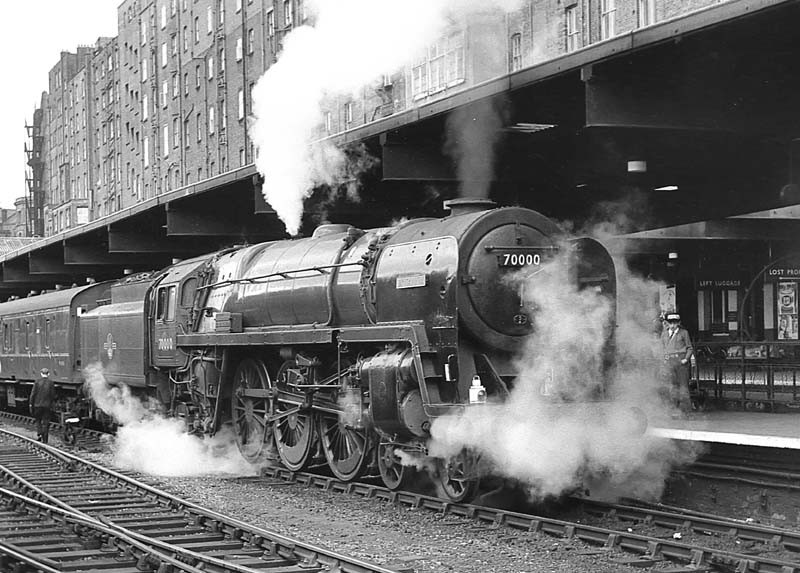 |
|
London North Western
Railway:

Midland
Railway:

Stratford
Midland Junction Railway
|

|
BR Period Locomotives: lnwrbns_br2885
 |
British Railways Standard Class 7MT 4-6-2 No 70000
'Britannia' stands at platform 3 on an up express on 22nd June 1963. Built by
Crewe works in January 1951, No 70000 was the first member of the class to be
built and was delivered new to 30A Stratford shed and then remained in service
until May 1966 when it was withdrawn from 9D Newton Heath shed for
preservation. The basic design of the Britannia Class owed much to LMS building
practices, especially when considering Riddles' previous career with the said
railway. However, in keeping with the necessity to follow best practice in
creating standardised steam locomotives, they utilised a variation of both
boiler and trailing wheel of the Merchant Navy Class, while weight was kept
within the margins laid down by the Light Pacifics, all of which were designed
by Oliver Bulleid. The firebox was also similar in having a rocking grate,
which allowed the fire to be rebuilt without stopping the locomotive, removing
both ash and clinker on the move. A self-cleaning smokebox was used, which
enabled ash to flow into the atmosphere, reducing the workload of the engine
cleaner at the end of a working day. A single chimney was placed on top of the
smokebox, which was unusual for a Pacific type of locomotive. This was because
the blastpipe was designed by SO Ell at Swindon Works, who claimed that "better
results could be obtained from a well-designed single chimney than some of the
previous double chimney arrangements". The Britannia Class had 6 ft 2 in
driving wheels, a compromise that took into account the intended mixed-traffic
role they were designed for. This meant that they were large enough for
sustained fast running with heavy passenger trains, yet small enough to allow
them to undertake more mundane tasks such as freight haulage.
The design also featured raised running plates above the
wheels, which allowed easy access to the inside of the frames for purposes of
lubrication. The lack of wheel splashers on this running plate also reduced the
risk of the bearings overheating, by allowing more air to flow around the axles
when at speed. Wheel splashers were used on older locomotive designs to box-in
the top portion of the driving wheels for aesthetic reasons, and to prevent
water and dirt from being thrown at the cab windows. The "Britannnias'"
footplate was designed around the requirements of the operating crews, with a
mock-up being constructed at Crewe to test ergonomics and usability. For ease
of maintenance, availability of spare parts and increased reliability, two sets
of Walschaerts valve gear were used, along with the largest cylinders capable
of staying within the British loading gauge. The "inside" cylinders located
between the frames of a three- or four-cylindered locomotive are difficult to
access for maintenance; the two-cylinder design of the Class 7 – with all
the valve gear on the outside – avoided these maintenance problems. Boiler
'plumbing' was also generally exposed to maintain ease of access.
Following experience of occasional cracks appearing near the
spring brackets had one or more further batches of Class 7 Standard Pacifics
been built to complete the intended 91 engines the chassis' would have been
rearranged to be similar to that used on the solitary Class 8 Standard Pacific
and that drawn up by Derby Drawing Office for the 2nd batch of Class 6 Standard
Pacifics. This would have resulted in the locomotive riding on cast steel
"sub-frames" carrying the spring brackets. Unlike the smaller BR Standards the
exhaust steam manifold within the smokebox saddle (along with the BR Standard
Class 6 engines) was an intricate steel casting.
 back back

|
